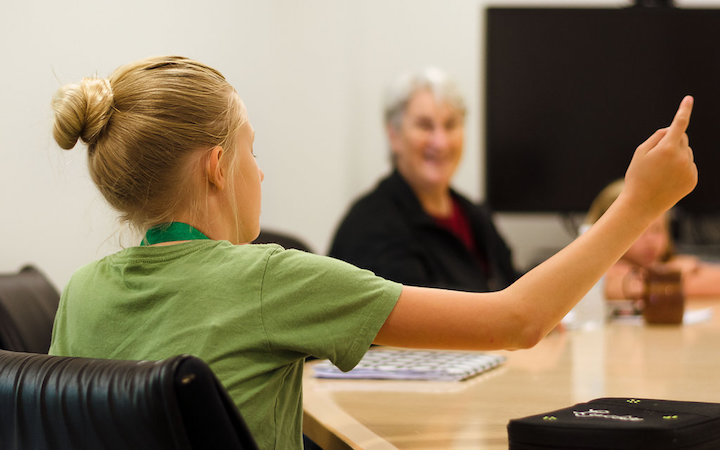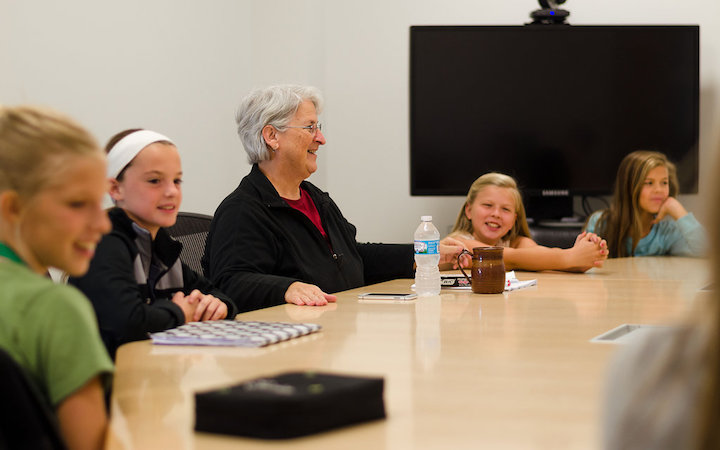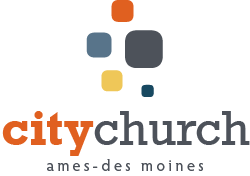Young Theologians: Ordered Learning in the CityChurch
Posted by Laura Rendall | Published September 14, 2016

“Isaiah 1-39 was written to God’s people in exile to recount God’s judgement against Israel and the nations and God’s promise for a Messiah and a good future to come when God is the eternal King.”
This statement sounds like it could have been written by an experienced theologian. As a matter of fact, though, it was written by Jade Roush, an eleven-year-old 6th grader in Kathy Keller’s ordered learning class. Kathy teaches the combined 5th and 6th grade class on Sunday mornings. In the 5th and 6th grade class, students pull together all the work from their previous years of ordered learning and write author’s intention statements for almost every book in the Bible. You might think that kids this age aren’t capable of doing that level of work, but Kathy argues otherwise. “They are capable of much more than we think they are,” she says.

The 5th and 6th grade years are a pivotal point for children. They are coming of age, joining their churches more formally as young adults, and are beginning to make their faith their own. The point of Kathy’s class is to help them to be able to go into the scriptures themselves and handle them with confidence. “This is their first run at mastering the scriptures, and our hope is that this is the beginning of a lifelong approach to studying the Bible,” says Kathy.
Kathy’s class is part of our church’s ordered learning plan: KidStories for 3-yr olds through kindergarten and KidStudies for 1st through 6th grades. At every level, the curriculum is based on author’s intention. In KidStories, stories have been chosen and lessons written based on what the author wanted to communicate. In KidStudies, the children are increasingly introduced to the question of author’s intention, and how to find it, so that by 5th and 6th grade, they are already in the habit of thinking about what the author intended to communicate. In 5th and 6th grades they begin to dig out those clues for themselves.

To find the author’s intention of a book, the class reads key texts, selected by Kathy, that cover the essential points the author is making. Then they focus on four key questions: Who is the author? When was it written? To whom was it written? What were the circumstances of the first readers? They ask what that author’s own intention was for those readers to learn and understand.
Kathy has been amazed at the capacity her class has shown for mastering this seemingly advanced study method. After all, these are the same skills that many of our adults are learning in Handling the Word with Confidence, and, on a very basic level, the Interpreting class. “The kids, they really get these concepts!” she says. She has seen their confidence in handling and dialoguing about scripture grow exponentially over the course of the class. Kathay describes how over the course of two years she gets to see them interact with the scriptures they cover in a deeper and deeper way. As they go, they gain confidence, and start making substantial contributions to the class.

During these two years, the kids refine two important skill sets: being able to find the author’s intent of a book and being able learn in the context of a dialogue with others. “When they start out they struggle,” says Kathy, “because they aren’t used to what we do. But as the class goes on you see them develop in their understanding of what author’s intention is and their sense of confidence just grows and grows.” By the end of the first year, she gets students who can finish with their preliminary author’s intention statement the first time they read a text. And she sees her class evolve from being very quiet to being able to dialogue together and build answers out of the group discussion.

Not only are these kids developmentally ready to master these important skill sets, they are also at an age where they can begin to make very adult contributions to their churches. A good example of a student doing this is Elijah Vos. His dad, Michael, takes time each week to help Elijah understand and refine his work for the class. “It is our job as [his] parents to ensure he knows the basic intentions of each of the biblical books,” explains Michael. Elijah then often brings his work to church and shares it. Michael says the effect of Elijah bringing his work to church has been twofold. First, it has shown everyone in the church that if an 11-year-old can do it, so can they. And it has demonstrated the importance of looking for the author’s intention of a text. “There’s a story about the first time Elijah brought his work to church,” says Kathy. “He brought his author’s intention statement for the book of Revelation. After he had presented it, several adults were just floored and said they had never heard such a clear explanation of that book before.”
Kathy hopes that the skills her students learn during class, and the body of work that they produce, are things that the kids will choose to revisit time and again. “I tell them, ‘You can do this. You are growing up,’” says Kathy. “And then it is amazing what I see these kids do.” Her desire for her class is to take these kids, who are on the brink of adulthood, and launch them on a lifelong trajectory of handling scripture well, and with confidence. Kathy knows that if her students and their families really invest themselves in the process, her class will be part of the bridge that helps our young people transition from childhood to adulthood in their churches.
Posted In
